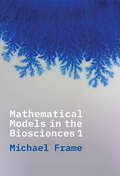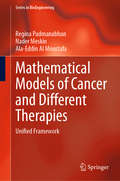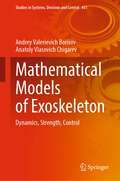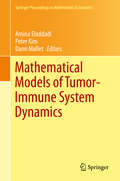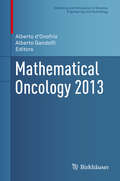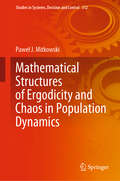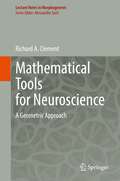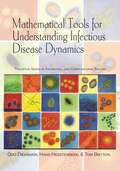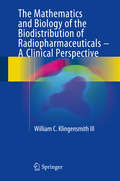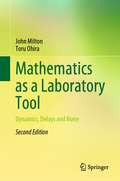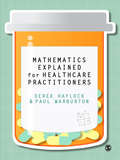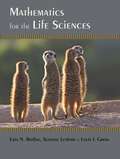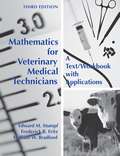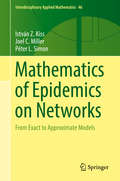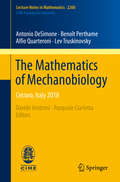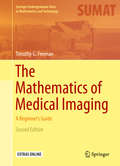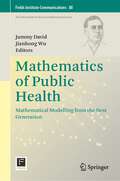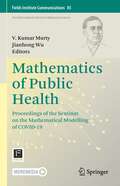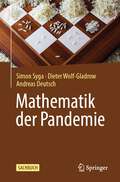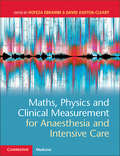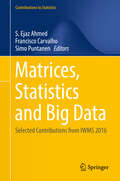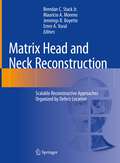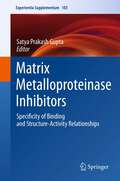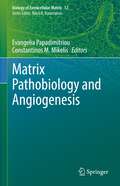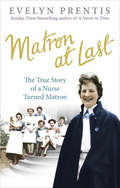- Table View
- List View
Mathematical Models in the Biosciences I
by Michael FrameAn award-winning professor’s introduction to essential concepts of calculus and mathematical modeling for students in the biosciences This is the first of a two-part series exploring essential concepts of calculus in the context of biological systems. Michael Frame covers essential ideas and theories of basic calculus and probability while providing examples of how they apply to subjects like chemotherapy and tumor growth, chemical diffusion, allometric scaling, predator-prey relations, and nerve impulses. Based on the author’s calculus class at Yale University, the book makes concepts of calculus more relatable for science majors and premedical students.
Mathematical Models of Cancer and Different Therapies: Unified Framework (Series in BioEngineering)
by Regina Padmanabhan Nader Meskin Ala-Eddin Al MoustafaThis book provides a unified framework for various currently available mathematical models that are used to analyze progression and regression in cancer development, and to predict its dynamics with respect to therapeutic interventions. Accurate and reliable model representations of cancer dynamics are milestones in the field of cancer research. Mathematical modeling approaches are becoming increasingly common in cancer research, as these quantitative approaches can help to validate hypotheses concerning cancer dynamics and thus elucidate the complexly interlaced mechanisms involved. Even though the related conceptual and technical information is growing at an exponential rate, the application of said information and realization of useful healthcare devices are lagging behind.In order to remedy this discrepancy, more interdisciplinary research works and course curricula need to be introduced in academic, industrial, and clinical organizations alike. To that end, this book reformulates most of the existing mathematical models as special cases of a general model, allowing readers to easily get an overall idea of cancer dynamics and its modeling. Moreover, the book will help bridge the gap between biologists and engineers, as it brings together cancer dynamics, the main steps involved in mathematical modeling, and control strategies developed for cancer management. This also allows readers in both medical and engineering fields to compare and contrast all the therapy-based models developed to date using a single source, and to identify unexplored research directions.
Mathematical Models of Exoskeleton: Dynamics, Strength, Control (Studies in Systems, Decision and Control #431)
by Andrey Valerievich Borisov Anatoly Vlasovich ChigarevThis book presents the current state of the problem of describing the musculoskeletal system of a person. Models of the destruction of the endoskeleton and the restoration of its functions using exoskeleton are presented. A description is given of new approaches to modeling based on the use of weightless rods of variable length with concentrated masses. The practical application to the tasks of numerical simulation of the movements of the musculoskeletal system of a person is described. Exoskeleton models with variable-length units based on absolutely hard sections and sections that change their telescopic type length have been developed.The book is intended for specialists in the field of theoretical mechanics, biomechanics, robotics and related fields. The book will be useful to teachers, as well as graduate students, undergraduates and senior students of higher educational institutions, whose research interests lie in the modeling of anthropomorphic biomechanical systems.
Mathematical Models of Tumor-Immune System Dynamics
by Amina Eladdadi Peter Kim Dann MalletThis collection of papers offers a broad synopsis of state-of-the-art mathematical methods used in modeling the interaction between tumors and the immune system. These papers were presented at the four-day workshop on Mathematical Models of Tumor-Immune System Dynamics held in Sydney, Australia from January 7th to January 10th, 2013. The workshop brought together applied mathematicians, biologists, and clinicians actively working in the field of cancer immunology to share their current research and to increase awareness of the innovative mathematical tools that are applicable to the growing field of cancer immunology. Recent progress in cancer immunology and advances in immunotherapy suggest that the immune system plays a fundamental role in host defense against tumors and could be utilized to prevent or cure cancer. Although theoretical and experimental studies of tumor-immune system dynamics have a long history, there are still many unanswered questions about the mechanisms that govern the interaction between the immune system and a growing tumor. The multidimensional nature of these complex interactions requires a cross-disciplinary approach to capture more realistic dynamics of the essential biology. The papers presented in this volume explore these issues and the results will be of interest to graduate students and researchers in a variety of fields within mathematical and biological sciences.
Mathematical Oncology 2013
by Alberto D'Onofrio Alberto GandolfiWith chapters on free boundaries, constitutive equations, stochastic dynamics, nonlinear diffusion-consumption, structured populations, and applications of optimal control theory, this volume presents the most significant recent results in the field of mathematical oncology. It highlights the work of world-class research teams, and explores how different researchers approach the same problem in various ways. Tumors are complex entities that present numerous challenges to the mathematical modeler. First and foremost, they grow. Thus their spatial mean field description involves a free boundary problem. Second, their interiors should be modeled as nontrivial porous media using constitutive equations. Third, at the end of anti-cancer therapy, a small number of malignant cells remain, making the post-treatment dynamics inherently stochastic. Fourth, the growth parameters of macroscopic tumors are non-constant, as are the parameters of anti-tumor therapies. Changes in these parameters may induce phenomena that are mathematically equivalent to phase transitions. Fifth, tumor vascular growth is random and self-similar. Finally, the drugs used in chemotherapy diffuse and are taken up by the cells in nonlinear ways. Mathematical Oncology 2013 will appeal to graduate students and researchers in biomathematics, computational and theoretical biology, biophysics, and bioengineering.
Mathematical Structures of Ergodicity and Chaos in Population Dynamics (Studies in Systems, Decision and Control #312)
by Paweł J. MitkowskiThis book concerns issues related to biomathematics, medicine, or cybernetics as practiced by engineers. Considered population dynamics models are still in the interest of researchers, and even this interest is increasing, especially now in the time of SARS-CoV-2 coronavirus pandemic, when models are intensively studied in order to help predict its behaviour within human population. The structures of population dynamics models and practical methods of finding their solutions are discussed. Finally, the hypothesis of the existence of non-trivial ergodic properties of the model of erythropoietic response dynamics formulated by A. Lasota in the form of delay differential equation with unimodal feedback is analysed. The research can be compared with actual medical data, as well as shows that the structures of population models can reflect the dynamic structures of reality.
Mathematical Tools for Neuroscience: A Geometric Approach (Lecture Notes in Morphogenesis)
by Richard A. ClementThis book provides a brief but accessible introduction to a set of related, mathematical ideas that have proved useful in understanding the brain and behaviour. If you record the eye movements of a group of people watching a riverside scene then some will look at the river, some will look at the barge by the side of the river, some will look at the people on the bridge, and so on, but if a duck takes off then everybody will look at it. How come the brain is so adept at processing such biological objects? In this book it is shown that brains are especially suited to exploiting the geometric properties of such objects. Central to the geometric approach is the concept of a manifold, which extends the idea of a surface to many dimensions. The manifold can be specified by collections of n-dimensional data points or by the paths of a system through state space. Just as tangent planes can be used to analyse the local linear behaviour of points on a surface, so the extension to tangent spaces can be used to investigate the local linear behaviour of manifolds. The majority of the geometric techniques introduced are all about how to do things with tangent spaces.Examples of the geometric approach to neuroscience include the analysis of colour and spatial vision measurements and the control of eye and arm movements. Additional examples are used to extend the applications of the approach and to show that it leads to new techniques for investigating neural systems. An advantage of following a geometric approach is that it is often possible to illustrate the concepts visually and all the descriptions of the examples are complemented by comprehensively captioned diagrams.The book is intended for a reader with an interest in neuroscience who may have been introduced to calculus in the past but is not aware of the many insights obtained by a geometric approach to the brain. Appendices contain brief reviews of the required background knowledge in neuroscience and calculus.
Mathematical Tools for Understanding Infectious Disease Dynamics (Princeton Series in Theoretical and Computational Biology #7)
by Odo Diekmann Hans Heesterbeek Tom BrittonMathematical modeling is critical to our understanding of how infectious diseases spread at the individual and population levels. This book gives readers the necessary skills to correctly formulate and analyze mathematical models in infectious disease epidemiology, and is the first treatment of the subject to integrate deterministic and stochastic models and methods.Mathematical Tools for Understanding Infectious Disease Dynamics fully explains how to translate biological assumptions into mathematics to construct useful and consistent models, and how to use the biological interpretation and mathematical reasoning to analyze these models. It shows how to relate models to data through statistical inference, and how to gain important insights into infectious disease dynamics by translating mathematical results back to biology. This comprehensive and accessible book also features numerous detailed exercises throughout; full elaborations to all exercises are provided.Covers the latest research in mathematical modeling of infectious disease epidemiologyIntegrates deterministic and stochastic approachesTeaches skills in model construction, analysis, inference, and interpretationFeatures numerous exercises and their detailed elaborationsMotivated by real-world applications throughout
The Mathematics and Biology of the Biodistribution of Radiopharmaceuticals - A Clinical Perspective
by William C Klingensmith IIIThis book explores the mathematics and biology of the biodistribution of radiopharmaceuticals following their introduction into the body, but does so primarily from a clinical perspective - from the point of view of image interpretation and any associated image-derived quantification. All of the equations included in the book relate directly to the biodistribution of radiopharmaceuticals and are clinically useful, either conceptually or because of their value in quantifying a biological parameter, e. g. , renal clearance. In particular, the more complex equations are not meant to be solved but instead are intended to provide a conceptual basis for the analysis of clinical images, especially those that are unusual and/or difficult to interpret. The efficacy of every diagnostic and therapeutic nuclear medicine procedure is critically dependent on the biodistribution of the radiopharmaceutical in question over time. This book will enable the reader to gain a sound understanding of the relevant mathematics and biology, and the clinical orientation ensures that it will be of value in enhancing clinical practice.
Mathematics as a Laboratory Tool: Dynamics, Delays and Noise
by John Milton Toru OhiraThe second edition of Mathematics as a Laboratory Tool reflects the growing impact that computational science is having on the career choices made by undergraduate science and engineering students. The focus is on dynamics and the effects of time delays and stochastic perturbations (“noise”) on the regulation provided by feedback control systems. The concepts are illustrated with applications to gene regulatory networks, motor control, neuroscience and population biology. The presentation in the first edition has been extended to include discussions of neuronal excitability and bursting, multistability, microchaos, Bayesian inference, second-order delay differential equations, and the semi-discretization method for the numerical integration of delay differential equations. Every effort has been made to ensure that the material is accessible to those with a background in calculus. The text provides advanced mathematical concepts such as the Laplace and Fourier integral transforms in the form of Tools. Bayesian inference is introduced using a number of detective-type scenarios including the Monty Hall problem.
Mathematics Explained for Healthcare Practitioners
by Derek Haylock Paul WarburtonIf you find mathematics a struggle, or if mathematics makes you panic - whether you′re a student preparing for a calculations test, or a qualified healthcare professional - this is the book for you. Its focus is first and foremost on helping you develop a proper and lasting understanding of mathematical concepts and processes in a healthcare context, with an emphasis on developing mental strategies to reinforce your feeling for number and numerical relationships. Clear, accessible chapters take you step-by-step through specific sets of objectives, and once you feel you have fully mastered a particular mathematical process, you′re encouraged to practise your skills through a range of practical examples. Each chapter also contains a ′Spot the Errors′ feature designed to reflect the busy, pressurised healthcare environment. Written by Derek Haylock, a best-selling mathematics educator, and Paul Warburton, co-ordinator of the Non-Medical Prescribing programme at Edge Hill University, the book is directly linked to the NMC′s competencies and will give you the confidence to perform the safe, error-free calculations required of all healthcare professionals.
Mathematics for the Life Sciences
by Erin N. Bodine Suzanne Lenhart Louis J. GrossAn accessible undergraduate textbook on the essential math concepts used in the life sciencesThe life sciences deal with a vast array of problems at different spatial, temporal, and organizational scales. The mathematics necessary to describe, model, and analyze these problems is similarly diverse, incorporating quantitative techniques that are rarely taught in standard undergraduate courses. This textbook provides an accessible introduction to these critical mathematical concepts, linking them to biological observation and theory while also presenting the computational tools needed to address problems not readily investigated using mathematics alone.Proven in the classroom and requiring only a background in high school math, Mathematics for the Life Sciences doesn't just focus on calculus as do most other textbooks on the subject. It covers deterministic methods and those that incorporate uncertainty, problems in discrete and continuous time, probability, graphing and data analysis, matrix modeling, difference equations, differential equations, and much more. The book uses MATLAB throughout, explaining how to use it, write code, and connect models to data in examples chosen from across the life sciences.Provides undergraduate life science students with a succinct overview of major mathematical concepts that are essential for modern biologyCovers all the major quantitative concepts that national reports have identified as the ideal components of an entry-level course for life science studentsProvides good background for the MCAT, which now includes data-based and statistical reasoningExplicitly links data and math modelingIncludes end-of-chapter homework problems, end-of-unit student projects, and select answers to homework problemsUses MATLAB throughout, and MATLAB m-files with an R supplement are available onlinePrepares students to read with comprehension the growing quantitative literature across the life sciencesA solutions manual for professors and an illustration package is available
Mathematics for Veterinary Medical Technicians (Third Edition)
by Edward M. Stumpf Frederick R. Fritz William W. BradfordThe text provides a one-semester course in the basics of mathematics needed for Veterinary Technicians and Assistants.
Mathematics of Epidemics on Networks
by Péter L. Simon Joel C. Miller István Z. KissThis textbook provides an exciting new addition to the area of network science featuring a stronger and more methodical link of models to their mathematical origin and explains how these relate to each other with special focus on epidemic spread on networks. The content of the book is at the interface of graph theory, stochastic processes and dynamical systems. The authors set out to make a significant contribution to closing the gap between model development and the supporting mathematics. This is done by: Summarising and presenting the state-of-the-art in modeling epidemics on networks with results and readily usable models signposted throughout the book; Presenting different mathematical approaches to formulate exact and solvable models; Identifying the concrete links between approximate models and their rigorous mathematical representation; Presenting a model hierarchy and clearly highlighting the links between model assumptions and model complexity; Providing a reference source for advanced undergraduate students, as well as doctoral students, postdoctoral researchers and academic experts who are engaged in modeling stochastic processes on networks; Providing software that can solve differential equation models or directly simulate epidemics on networks. Replete with numerous diagrams, examples, instructive exercises, and online access to simulation algorithms and readily usable code, this book will appeal to a wide spectrum of readers from different backgrounds and academic levels. Appropriate for students with or without a strong background in mathematics, this textbook can form the basis of an advanced undergraduate or graduate course in both mathematics and other departments alike.
The Mathematics of Mechanobiology: Cetraro, Italy 2018 (Lecture Notes in Mathematics #2260)
by Antonio DeSimone Benoît Perthame Alfio Quarteroni Lev TruskinovskyThis book presents the state of the art in mathematical research on modelling the mechanics of biological systems – a science at the intersection between biology, mechanics and mathematics known as mechanobiology. The book gathers comprehensive surveys of the most significant areas of mechanobiology: cell motility and locomotion by shape control (Antonio DeSimone); models of cell motion and tissue growth (Benoît Perthame); numerical simulation of cardiac electromechanics (Alfio Quarteroni); and power-stroke-driven muscle contraction (Lev Truskinovsky).Each section is self-contained in terms of the biomechanical background, and the content is accessible to all readers with a basic understanding of differential equations and numerical analysis. The book disentangles the phenomenological complexity of the biomechanical problems, while at the same time addressing the mathematical complexity with invaluable clarity. The book is intended for a wide audience, in particular graduate students and applied mathematicians interested in entering this fascinating field.
The Mathematics of Medical Imaging
by Timothy G. FeemanThe basic mathematics of computerized tomography, the CT scan, are aptly presented for an audience of undergraduates in mathematics and engineering. Assuming no prior background in advanced mathematical analysis, topics such as the Fourier transform, sampling, and discrete approximation algorithms are introduced from scratch and are developed within the context of medical imaging. A chapter on magnetic resonance imaging focuses on manipulation of the Bloch equation, the system of differential equations that is the foundation of this important technology. Extending the ideas of the acclaimed first edition, new material has been adeed to render an even more accessible textbook for course usage. This edition includes new discussions of the Radon transform, the Dirac delta function and its role in X-ray imaging, Kacmarz's method and least squares approximation, spectral filtering, and more. Copious examples and exercises, new computer-based exercises, and additional graphics have been added to further delineate concepts. The use of technology has been revamped throughout with the incorporation of the open source programming environment R to illustrate examples and composition of graphics. All R code is available as extra source material on SpringerLink. From the reviews of the first edition: "This book is valuable, for it addresses with care and rigor the relevance of a variety of mathematical topics to a real-world problem. . . . T his book is well written. It serves its purpose of focusing a variety of mathematical topics onto a real-world application that is in its essence mathematics. " -The Journal of Nuclear Medicine, Vol. 51 (12), December, 2010 "This new book by Timothy Feeman, truly intended to be a beginner's guide, makes the subject accessible to undergraduates with a working knowledge of multivariable calculus and some experience with vectors and matrix methods. . . . author handles the material with clarity and grace. . . " -The Mathematical Association of America, February, 2010
Mathematics of Public Health: Mathematical Modelling from the Next Generation (Fields Institute Communications #88)
by Jummy David Jianhong WuThis volume addresses SDG 3 from a mathematical standpoint, sharing novel perspectives of existing communicable disease modelling technologies of the next generation and disseminating new developments in modelling methodologies and simulation techniques. These methodologies are important for training and research in communicable diseases and can be applied to other threats to human health. The contributions contained in this collection/book cover a range of modelling techniques that have been and may be used to support decision-making on critical health related issues such as: Resource allocation Impact of climate change on communicable diseases Interaction of human behaviour change, and disease spread Disease outbreak trajectories projection Public health interventions evaluation Preparedness and mitigation of emerging and re-emerging infectious diseases outbreaks Development of vaccines and decisions around vaccine allocation and optimization The diseases and public health issues in this volume include, but are not limited to COVID-19, HIV, Influenza, antimicrobial resistance (AMR), the opioid epidemic, Lyme Disease, Zika, and Malaria. In addition, this volume compares compartmental models, agent-based models, machine learning and network. Readers have an opportunity to learn from the next generation perspective of evolving methodologies and algorithms in modelling infectious diseases, the mathematics behind them, the motivation for them, and some applications to supporting critical decisions on prevention and control of communicable diseases. This volume was compiled from the weekly seminar series organized by the Mathematics for Public Health (MfPH) Next Generation Network. This network brings together the next generation of modellers from across Canada and the world, developing the latest mathematical models, modeling methodologies, and analytical and simulation tools for communicable diseases of global public health concerns. The weekly seminar series provides a unique forum for this network and their invited guest speakers to share their perspectives on the status and future directions of mathematics of public health.
Mathematics of Public Health: Proceedings of the Seminar on the Mathematical Modelling of COVID-19 (Fields Institute Communications #85)
by Jianhong Wu V. Kumar MurtyCurated by the Fields Institute for Research in Mathematical Sciences from their COVID-19 Math Modelling Seminars, this first in a series of volumes on the mathematics of public health allows readers to access the dominant ideas and techniques being used in this area, while indicating problems for further research. This work brings together experts in mathematical modelling from across Canada and the world, presenting the latest modelling methods as they relate to the COVID-19 pandemic. A primary aim of this book is to make the content accessible so that researchers share the core methods that may be applied elsewhere. The mathematical theories and technologies in this book can be used to support decision makers on critical issues such as projecting outbreak trajectories, evaluating public health interventions for infection prevention and control, developing optimal strategies to return to a new normal, and designing vaccine candidates and informing mass immunization program. Topical coverage includes: basic susceptible-exposed-infectious-recovered (SEIR) modelling framework modified and applied to COVID-19 disease transmission dynamics; nearcasting and forecasting for needs of critical medical resources including personal protective equipment (PPE); predicting COVID-19 mortality; evaluating effectiveness of convalescent plasma treatment and the logistic implementation challenges; estimating impact of delays in contact tracing; quantifying heterogeneity in contact mixing and its evaluation with social distancing; modelling point of care diagnostics of COVID-19; and understanding non-reporting and underestimation. Further, readers will have the opportunity to learn about current modelling methodologies and technologies for emerging infectious disease outbreaks, pandemic mitigation rapid response, and the mathematics behind them. The volume will help the general audience and experts to better understand the important role that mathematics has been playing during this on-going crisis in supporting critical decision-making by governments and public health agencies.
Mathematik der Pandemie
by Simon Syga Dieter Wolf-Gladrow Andreas DeutschDie COVID-19-Pandemie hat weltweit dramatische Folgen. Mathematische Modelle spielen bei ihrer Bewertung eine zentrale Rolle: Sie sollen die Wirkung von Maßnahmen abschätzen, die oft mit Einschränkungen individueller Freiheiten einhergehen. Umso mehr sollte das Wissen um die Mathematik der Pandemie nicht nur Experten überlassen bleiben. Dieses Buch erläutert grundlegende Begriffe und Modelle, und klärt weitverbreitete Missverständnisse auf. Das Buch gibt insbesondere Antwort auf folgende Fragen:Was sagen Kennzahlen wie Inzidenz, Reproduktionszahl, Hospitalisierungsrate oder Impfquote über die Pandemie?Was ist der Unterschied von linearem und exponentiellem Wachstum?Was ist Herdenimmunität? Warum werden sich trotz Herdenimmunität fast alle Ungeimpften anstecken?Was ist der Effekt von Kontaktbeschränkungen und Impfung?Warum sind Vorhersagen in der Pandemie schwierig?
Maths, Physics and Clinical Measurement for Anaesthesia and Intensive Care
by Hozefa Ebrahim Ashton-Cleary DavidMaths, physics and clinical measurement hold a degree of mystery and trepidation for many working and training in anaesthesia, intensive care and theatre practice. This important new book covers these core topics in a logical and structured format, creating a more enjoyable learning experience that is accessible and easy to digest. Each chapter opens with a set of learning objectives and summary of chapter contents. Following this is a clinical scenario that relates to the themes of the chapter and a number of hypothetical questions relating to the scenario are laid-out. Clinical pearls are presented in boxes for more advanced learning opportunities. Each chapter closes with a set of MCQ or SBA self-test questions to test the readers' knowledge of the chapter. This book covers everything needed for the FFICM and FRCA exams, making it an essential text for exam candidates, tutors, and those working in theatres, anaesthesia and the ICU.
Matrices, Statistics and Big Data: Selected Contributions from IWMS 2016 (Contributions to Statistics)
by S. Ejaz Ahmed Francisco Carvalho Simo PuntanenThis volume features selected, refereed papers on various aspects of statistics, matrix theory and its applications to statistics, as well as related numerical linear algebra topics and numerical solution methods, which are relevant for problems arising in statistics and in big data. The contributions were originally presented at the 25th International Workshop on Matrices and Statistics (IWMS 2016), held in Funchal (Madeira), Portugal on June 6-9, 2016. The IWMS workshop series brings together statisticians, computer scientists, data scientists and mathematicians, helping them better understand each other’s tools, and fostering new collaborations at the interface of matrix theory and statistics.
Matrix Head and Neck Reconstruction: Scalable Reconstructive Approaches Organized by Defect Location
by Brendan C. Stack Mauricio A. Moreno Jennings R. Boyette Emre A. VuralHead and neck reconstruction can be challenging due to the anatomical complexity of the area, its impact upon function, and the common need for adjuvant treatment postoperatively in cases of malignancy. Furthermore, the results are very visible and may significantly affect the patient’s ability to reintegrate socially. This unique surgical atlas is organized as a matrix of options, from simple to complex, covering all described anatomical areas of the head and neck. The organization of defects and reconstructive options, combined with illustrations and high-resolution intraoperative photography, make this the premier reconstructive reference that will be accessible when difficult reconstructive situations arise. The matrix concept is a unique approach to organizing and presenting facial, head and neck defects. Most clinical cases present as a defect or as the potential for a defect after a resection. The matrix approach is a human cognitive approach to problem solving. This atlas allows the reader to search out their potential defects and study the possible reconstructive options available to them. This spectrum of possibilities may help the surgeon to decide whether to manage on the case on their own or refer it for more expertise. It is also a visible tool to assist surgeons in reviewing options and making decisions with patients in the informed consent process.The matrix presents defects with internal consistency throughout the text and is organized in an anatomic order. Each anatomic sub-site is further subdivided into recognized clinical sub-units, and each potential defect is then illustrated in a standardized fashion to promote clarity and uniformity for easy reference. Commonly associated defects are linked. Each specific defect is then addressed, presenting reconstructive options of increasing complexity, with photography to show a staged approach to pre-reconstruction, site preparation, flap selection, flap inset, and final results acutely post-operatively and at a delayed time point.Matrix Head and Neck Reconstruction combines and distills the work of major head and neck reconstruction and facial plastic surgery to provide a broad and deep resource that is highly pictorial and practical in providing a scalable approach to reconstruction.
Matrix Metalloproteinase Inhibitors
by Satya Prakash GuptaMatrix metalloproteinases (MMPs) are proteolytic enzymes that are involved in many physiological and pathological processes. The field of MMP research is very important due to the implications of the distinct paralogs in both human physiology and pathology. Over-activation of these enzymes results in tissue degradation, producing a wide array of disease processes such as rheumatoid arthritis, osteoarthritis, tumor growth and metastasis, multiple sclerosis, congestive heart failure, and others. Thus MMP inhibitors are candidates for therapeutic agents to combat a number of diseases. The present book discusses the design and development of different classes of inhibitors of important classes of MMPs, such as gelatinases and collagenases. The articles focus specifically on structure-activity relationships of all classes of compounds and on their modes of action and specificity of binding with the receptors based on experimental and theoretical studies. These studies constitute a valuable asset for all those involved in drug development.
Matrix Pathobiology and Angiogenesis (Biology of Extracellular Matrix #12)
by Evangelia Papadimitriou Constantinos M. MikelisIn the vasculature, the extracellular matrix (ECM) is involved in the regulation of angiogenesis, vascular mechanosensing, and blood vessel stability. This book aims to provide the reader with an overview of the various roles of the ECM during angiogenesis and covers its important role for the maintenance of vascular integrity, capillary and arterial morphogenesis, as well as lymphangiogenesis. Furthermore, aspects of regulation of endothelial cell and pericyte functions by the ECM under physiological and pathological conditions are discussed. In addition, the reader will learn more about different approaches to exploit ECM molecules for designing therapeutic approaches or as biomarkers to improve therapeutic decisions. Comprehensive and cutting-edge, Matrix Pathobiology and Angiogenesis is a valuable resource for experienced researchers and early career scientist alike, who are interested in in learning more about this exciting and developing field. The series Biology of Extracellular Matrix is published in collaboration with the American Society for Matrix Biology and the International Society for Matrix Biology.
Matron at Last
by Evelyn Prentis'When do you have a bath?' I asked Mrs Turgoose. 'I hope you're not suggesting that I don't look after meself properly,' she said crossly. 'There was a woman who used to use it, but that was because she was a bit stuck up. She soon went off the idea when it started to get cold.'After working as a nurse for thirty years, Evelyn left the hospital to become a full-time Matron at The Lodge - a home for elderly ladies of reduced circumstances. Evelyn was nothing like the matrons she had known and feared in the past. In spite of broken nights and hot dinners left to get cold, Mrs Peters with her temper and Mrs Harrison with her 24-hour piano playing, her new role offered a chance to make a difference to her ladies' lives. Even though it did mean she was on call twenty-four hours a day, this is Evelyn's funny and affectionate memoir of her years - at last! - as a Matron.
